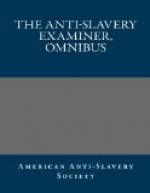“The slaves, naked and starved, often fall victims to the inclemencies of the weather.”
Wm. Savery of Philadelphia, an eminent Minister of the Society of Friends, who went through the Southern states in 1791, on a religious visit; after leaving Savannah, Ga., we find the following entry in his journal, 6th, month, 28, 1791.
“We rode through many rice swamps, where the blacks were very numerous, great droves of these poor slaves, working up to the middle in water, men and women nearly naked.”
Rev. John Rankin, of Ripley, Ohio, a native of Tennessee.
“In every slave-holding state, many slaves suffer extremely, both while they labor and while they sleep, for want of clothing to keep them warm.”
John Parrish, late of Philadelphia, a highly esteemed minister in the Society of Friends, who travelled through the South in 1804.
“It is shocking to the feelings of humanity, in travelling through some of those states, to see those poor objects, [slaves,] especially in the inclement season, in rags, and trembling with the cold.”
“They suffer them, both male and female, to go without clothing at the age of ten and twelve years”
Rev. Phineas Smith, Centreville, Allegany, Co., N.Y. Mr. S. has just returned from a residence of several years at the south, chiefly in Virginia, Louisiana, and among the American settlers in Texas.
“The apparel of the slaves, is of the coarsest sort and exceedingly deficient in quantity. I have been on many plantations where children of eight and ten yeas old, were in a state of perfect nudity. Slaves are in general wretchedly clad.”
Wm. Ladd, Esq., of Minot, Maine, recently a slaveholder in Florida.
“They were allowed two suits of clothes a year, viz. one pair of trowsers with a shirt or frock of osnaburgh for summer; and for winter, one pair of trowsers, and a jacket of negro cloth, with a baize shirt and a pair of shoes. Some allowed hats, and some did not; and they were generally, I believe, allowed one blanket in two years. Garments of similar materials were allowed the women.”
A Kentucky physician, writing in the Western Medical Reformer, in 1836, on the diseases peculiar to slaves, says.
“They are imperfectly clothed both summer and winter.”
Mr. Stephen E. Maltby, Inspector of provisions, Skeneateles, N.Y., who resided sometime in Alabama.
“I was at Huntsville, Alabama, in 1818-19, I frequently saw slaves on and around the public square, with hardly a rag of clothing on them, and in a great many instances with but a single garment both in summer and in winter; generally the only bedding of the slaves was a blanket.”
Reuben G. Macy, Hudson, N.Y. member of the Society of Friends, who resided in South Carolina, in 1818 and 19.




